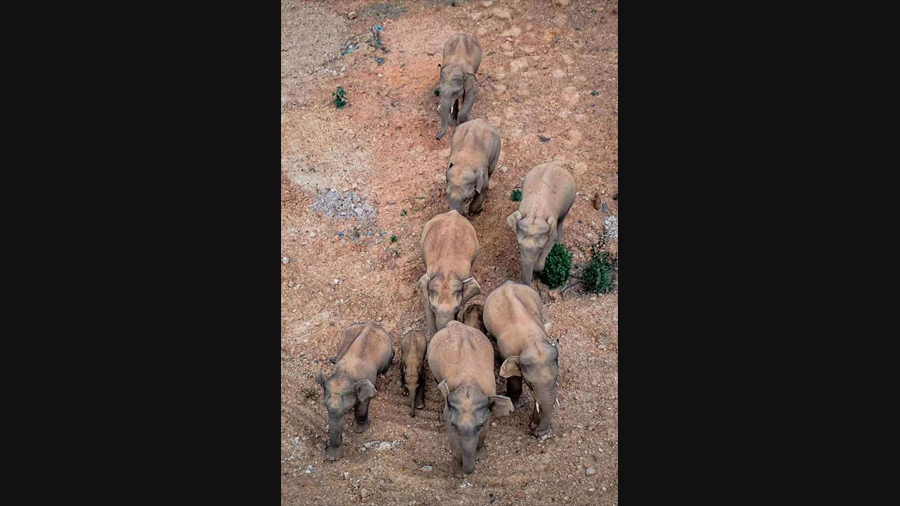
Herd of 15 Asian elephants lumbering across China for more than a year
They have been travelling more than 300 miles through villages, forests patches, and, as of 9.55pm (local time) on Wednesday, the edges of the city of Kunming

No one is quite sure. But for some reason, a herd of 15 Asian elephants has been lumbering its way across China for more than a year, travelling more than 300 miles through villages, forest patches — and, as of 9.55pm (local time) on Wednesday, the edges of the city of Kunming, population 8.5 million.
Since setting out in spring last year from Xishuangbanna National Nature Reserve, on China’s far southwestern border with Laos, the elephants have trotted down the middle of a narrow county street, past a shuttered car dealership and gawking residents. They have got into stores of grains left over from fermentation, leading to reports of at least one drunken elephant. They have devoured truckloads of corn and pineapples left out by government officials in an effort to divert them to less populated areas — and then continued on their way.
It’s the farthest-known movement of elephants in China, according to experts. Where they’ll go next, no one knows. When they’ll stop? Also unclear. “It makes me think of the movie Nomadland,” said Becky Shu Chen, a consultant for the Zoological Society of London who has studied elephant-human interactions.
What is certain is that they have captivated Chinese social media, jolted local officials and caused more than $1.1 million of damage. They have also left elephant researchers scratching their heads.
Experts are urging the public to temper its delight with awareness of the ecological significance, in a country where avid enthusiasm for conservation has not necessarily coincided with a reckoning of what it will mean to live alongside more elephants.
“This is part of the deal,” said Ahimsa Campos-Arceiz, a principal investigator at the Xishuangbanna Tropical Botanical Garden, who specialises in elephants. “We want to conserve elephants and tigers. But we don’t have 10,000 square kilometres to put these elephants and tigers and say, ‘Be happy there, don’t worry.’”
The journey appears to have begun last March, when 16 elephants were seen moving from the nature reserve northwards towards the city of Pu’er, in southern Yunnan province, according to state media.
But movement is normal for elephants, which have large “home ranges” over which they travel searching for food, said Dr Campos-Arceiz. So it was not until relatively recently that researchers and government officials began to notice just how far this herd had wandered. In April, the elephants were spotted around Yuanjiang county, about 230 miles north of the nature reserve.
By then, a few elephants had turned around, while others had been born, according to officials. The group now consists of 15 animals.
It’s not clear what spurred the elephants to leave their home. But after conservation efforts, China’s elephant population has grown in recent years, from fewer than 200 several decades ago to around 300 today, according to official statistics. (Researchers say actual numbers are unclear.) At the same time, deforestation has reduced their habitat.
The elephants’ growing proximity to humans — and their strictly protected status — has emboldened the animals, according to Dr Campos-Arceiz. And, they’re smart: As they began breaching the boundaries of nature reserves and crossing into more populated areas, they discovered that crops were more appealing than their usual forest fare.
“Elephants learned there is so much food, it’s so nutritious, it’s so easy to harvest and it’s safe,” Dr Campos-Arceiz said.
As a result, it’s unsurprising to see elephants wandering beyond their usual habitats, he said, and the phenomenon is likely to continue as their population continues to grow. (In fact, Dr Campos-Arceiz rescheduled an interview on Wednesday night because he was in the Xishuangbanna gardens in the dark, trailing another elephant herd that had meandered about 40 miles from its home range.)
Still, that doesn’t explain the long-distance movement of the “northbound wild elephant herd”, as the other herd has come to be known on social media.
“No idea,” Dr. Campos-Arceiz said of why the group had yet to settle in one spot. “Don’t trust anyone who gives you a very clear response.”
The absence of clarity has not at all dampened the public’s enjoyment of the animals’ long march. Social media users have cooed over videos of an older elephant rescuing a calf that fell into a gutter. They have suggested that if the elephants hurry, they will arrive in Beijing in time for the Chinese Communist Party’s 100th anniversary next month. Even Xinhua has referred to the herd as a “tour group”.
On Thursday, the hashtag “northbound wild elephants’ buffet site” trended on Weibo after residents in a village near Kunming prepared cartloads of corn stalks for them.
New York Times News Service

0 Response to " Herd of 15 Asian elephants lumbering across China for more than a year"
Post a Comment
Kalimpong News is a non-profit online News of Kalimpong Press Club managed by KalimNews.
Please be decent while commenting and register yourself with your email id.
Note: only a member of this blog may post a comment.